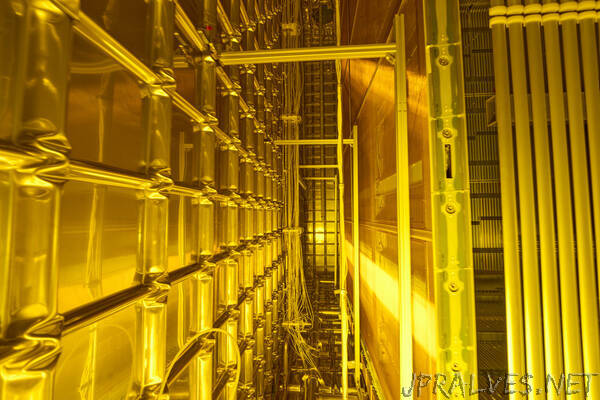
“The teams at CERN’s Neutrino Platform are currently upgrading and assembling multiple detectors to help large experiments in the USA and Japan to uncover these mysterious particles.
At CERN’s Neutrino Platform on the Laboratory’s Prévessin site in France sit two large boxes encased in a red grating. Inside these boxes are vast chambers surrounded by shiny stainless steel. The boxes are the cryostat modules of the ProtoDUNE experiment. Despite their large size, they are tiny in comparison to the future size of their successors for the Deep Underground Neutrino Experiment (DUNE), a vast neutrino experiment currently being built in the USA. The Neutrino Platform also houses an assembly station for the Tokai to Kamioka (T2K) experiment, another vast neutrino facility in Japan.
Neutrinos are one of the least well-known types of particles in the Standard Model. Although they are the most abundant massive particles in the Universe, neutrinos have very small mass and only interact through gravity and the weak nuclear force, making them difficult to study. However, neutrinos may hold the key to fundamental questions such as why the Universe is filled with matter and not antimatter. So-called long-baseline neutrino-oscillation experiments could help to answer these questions by studying how neutrinos change their “flavour”, or oscillate, as they travel over a long distance, or baseline.
Once built in the USA, DUNE will send a beam of neutrinos from Fermi National Accelerator Laboratory (Fermilab) near Chicago, Illinois, over a distance of more than 1300 kilometres through the Earth to neutrino detectors located 1.5 km underground at the Sanford Underground Research Facility (SURF) in Sanford, South Dakota. The detectors themselves are vast cryostats filled with liquid argon. When neutrinos interact with the argon, which happens only occasionally, this ionises the argon atoms. The loose electrons and argon atoms are then separated by an electric field that runs through the detector. The shape of the electron cloud created by the ionisation is conserved and detected by the electrode sensors located on the walls of the cryostat. This produces images of the trajectories of particles created by the neutrino interactions, allowing physicists to determine the neutrinos’ properties such as their flavour and mass. These detectors, which use a combination of electric fields passing through a volume of fluid, are called time projection chambers.
Back to Prévessin. In 2018, ProtoDUNE began its first run. Both cryostats were tested until 2021, the first in a single-phase configuration of the experiment (ProtoDUNE-SP) and the second in a dual-phase configuration (ProtoDUNE-DP). The first run recorded over four million particle interactions, providing important information about the technology challenges associated with DUNE, and demonstrated that the full experiment was ready for construction. Since January 2023, the Neutrino Platform has been preparing for ProtoDUNE’s second run. The two cryostats are both now single-phase, one measuring the drift of electrons across a horizontal electric field (ProtoDUNE-HD) and the other across a vertical field (ProtoDUNE-VD). Scientists will use this second run to determine how these technologies should be implemented in DUNE. The two cryostats will be filled with liquid argon soon and will begin taking data at the beginning of next year.
The Neutrino Platform also hosts the assembly platform for the T2K experiment. T2K has already been operating for over a decade in Japan, sending beams of neutrinos from Tokai on the East coast over a distance of 295 km to the Super-Kamiokande detector in Kamioka, close to the West coast. In 2011, T2K provided the first evidence of muon neutrino-to-electron-neutrino oscillations and has since hinted at neutrino matter–antimatter asymmetry. One of its detectors, ND280, is currently undergoing an upgrade, which the T2K collaboration hopes will allow it to increase the efficiency of the experiment and more accurately reconstruct the neutrino oscillations.
The ND280 upgrade consists of multiple subdetectors, many of which were assembled and tested at the Neutrino Platform. These include new time projection chambers, one of which is now currently taking cosmic data at CERN. Other types of subdetectors are either already installed or ready to be shipped to Japan after assembly at the Neutrino Platform. As well as individual subdetectors, the new gas system for the whole ND280 detector was completely developed and tested at CERN. Still to be completed is the assembly of another time projection chamber, and its shipment to and installation at T2K. The ND280 upgrade is projected to be finalised in 2023. It is planned that the upgraded ND280 will also serve in the next generation long-baseline neutrino oscillation experiment known as Hyper-Kamiokande (HyperK).”
